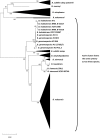Iturinic Lipopeptide Diversity in the Bacillus subtilis Species Group - Important Antifungals for Plant Disease Biocontrol Applications
- PMID: 31440222
- PMCID: PMC6693446
- DOI: 10.3389/fmicb.2019.01794
Iturinic Lipopeptide Diversity in the Bacillus subtilis Species Group - Important Antifungals for Plant Disease Biocontrol Applications
Abstract
Iturins and closely related lipopeptides constitute a family of antifungal compounds known as iturinic lipopeptides that are produced by species in the Bacillus subtilis group. The compounds that comprise the family are: iturin, bacillomycin D, bacillomycin F, bacillomycin L, mycosubtilin, and mojavensin. These lipopeptides are prominent in many Bacillus strains that have been commercialized as biological control agents against fungal plant pathogens and as plant growth promoters. The compounds are cyclic heptapeptides with a variable length alkyl sidechain, which confers surface activity properties resulting in an affinity for fungal membranes. Above a certain concentration, enough molecules enter the fungal cell membrane to create a pore in the cell wall, which leads to loss of cell contents and cell death. This study identified 330 iturinic lipopeptide clusters in publicly available genomes from the B. subtilis species group. The clusters were subsequently assigned into distinguishable types on the basis of their unique amino acid sequences and then verified by HPLC MS/MS analysis. The results show some lipopeptides are only produced by one species, whereas certain others can produce up to three. In addition, four species previously not known to produce iturinic lipopeptides were identified. The distribution of these compounds among the B. subtilis group species suggests that they play an important role in their speciation and evolution.
Keywords: FZB42; PGPR; QST713; amyloliquefaciens; biocontrol; biostimulant; fengycin; probiotic.
Figures





Similar articles
-
Fengycins, Cyclic Lipopeptides from Marine Bacillus subtilis Strains, Kill the Plant-Pathogenic Fungus Magnaporthe grisea by Inducing Reactive Oxygen Species Production and Chromatin Condensation.Appl Environ Microbiol. 2018 Aug 31;84(18):e00445-18. doi: 10.1128/AEM.00445-18. Print 2018 Sep 15. Appl Environ Microbiol. 2018. PMID: 29980550 Free PMC article.
-
The plant-associated Bacillus amyloliquefaciens strains MEP2 18 and ARP2 3 capable of producing the cyclic lipopeptides iturin or surfactin and fengycin are effective in biocontrol of sclerotinia stem rot disease.J Appl Microbiol. 2012 Jan;112(1):159-74. doi: 10.1111/j.1365-2672.2011.05182.x. Epub 2011 Nov 22. J Appl Microbiol. 2012. PMID: 22017648
-
Characterization ofantifungal properties of lipopeptide-producing Bacillus velezensis strains and their proteome-based response to the phytopathogens, Diaporthe spp.Front Bioeng Biotechnol. 2023 Aug 7;11:1228386. doi: 10.3389/fbioe.2023.1228386. eCollection 2023. Front Bioeng Biotechnol. 2023. PMID: 37609113 Free PMC article.
-
Biological control of plant pathogens by Bacillus species.J Biotechnol. 2018 Nov 10;285:44-55. doi: 10.1016/j.jbiotec.2018.07.044. Epub 2018 Aug 30. J Biotechnol. 2018. PMID: 30172784 Review.
-
Ecological and mechanistic insights into the direct and indirect antimicrobial properties of Bacillus subtilis lipopeptides on plant pathogens.J Chem Ecol. 2013 Jul;39(7):869-78. doi: 10.1007/s10886-013-0319-7. Epub 2013 Jul 16. J Chem Ecol. 2013. PMID: 23888387 Review.
Cited by
-
Bacillus species as tools for biocontrol of plant diseases: A meta-analysis of twenty-two years of research, 2000-2021.World J Microbiol Biotechnol. 2024 Feb 27;40(4):110. doi: 10.1007/s11274-024-03935-x. World J Microbiol Biotechnol. 2024. PMID: 38411743
-
Process Development in Biosurfactant Production.Adv Biochem Eng Biotechnol. 2022;181:195-233. doi: 10.1007/10_2021_195. Adv Biochem Eng Biotechnol. 2022. PMID: 35246695 Review.
-
Characterisation of antagonistic Bacillus paralicheniformis (strain EAL) by LC-MS, antimicrobial peptide genes, and ISR determinants.Antonie Van Leeuwenhoek. 2020 Aug;113(8):1167-1177. doi: 10.1007/s10482-020-01423-4. Epub 2020 May 15. Antonie Van Leeuwenhoek. 2020. PMID: 32410087
-
Antimicrobial Compounds from Microorganisms.Antibiotics (Basel). 2022 Feb 22;11(3):285. doi: 10.3390/antibiotics11030285. Antibiotics (Basel). 2022. PMID: 35326749 Free PMC article. Review.
-
Antifungal effect of soil Bacillus bacteria on pathogenic species of the fungal genera Aspergillus and Trichophyton.Iran J Microbiol. 2025 Apr;17(2):303-311. doi: 10.18502/ijm.v17i2.18397. Iran J Microbiol. 2025. PMID: 40337676 Free PMC article.
References
-
- Delcambe L. (1950). Iturine, new antibiotic produced by Bacillus subtilis. C. R. Seances Soc. Biol. Fil. 144 1431–1434. - PubMed
LinkOut - more resources
Full Text Sources
Molecular Biology Databases

